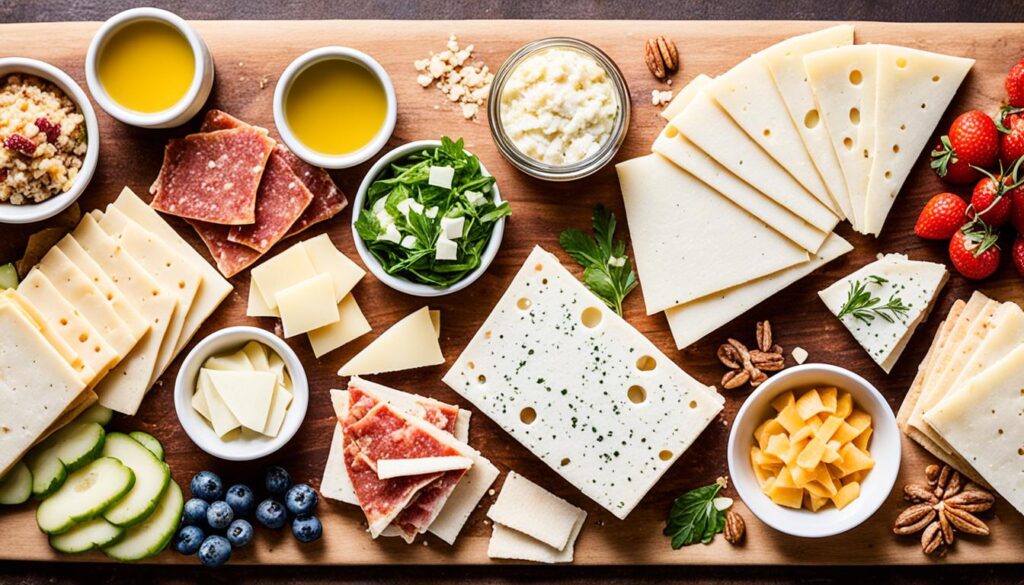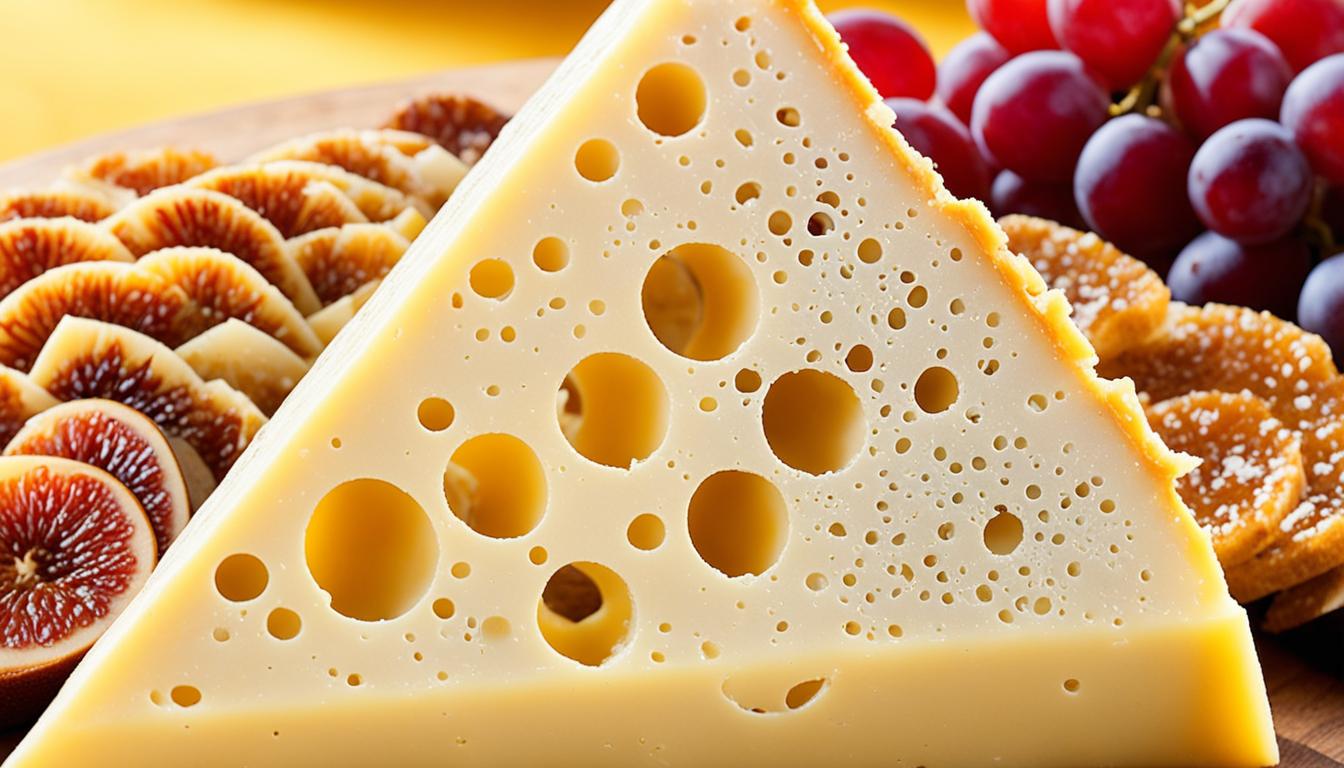Welcome to our ultimate guide to Manchego cheese, the beloved Spanish sheep’s milk cheese that has been delighting cheese enthusiasts for centuries. Have you ever wondered what makes Manchego cheese so special? How does its rich history and traditional production methods contribute to its unique flavor? Join us as we embark on a journey to explore the depths of this iconic cheese and discover its incredible versatility in the kitchen.
But first, let’s take a moment to appreciate the beauty of Manchego cheese. Just look at this mouthwatering image that showcases the golden hues and distinct herringbone pattern of this Spanish delight:
Now, let’s dive deeper into the world of Manchego cheese, from its historical origins to the intricate production process. We’ll examine the different varieties of Manchego cheese, each with its own unique characteristics, and discover how this versatile cheese can elevate your culinary creations.
Are you ready to unlock the secrets of Manchego cheese? Let’s begin our journey and become true connoisseurs of this traditional Spanish delicacy!
History and Origin of Manchego Cheese
Manchego cheese has a long and rich history that can be traced back to Roman times. The cheese originates from the La Mancha region in central Spain, known for its high, flat lands that have been home to the Manchega sheep for centuries. This native breed of sheep provides the milk used to make Manchego cheese.
In the Middle Ages, Manchego cheese played a significant role in the local economy, with the production and trade of the cheese regulated by specific laws. The cheese’s popularity continued to grow over the centuries, and it even found mention in Miguel de Cervantes’ famous work, “Don Quixote,” highlighting its cultural importance in Spanish literature.
In recognition of its historical significance and traditional production methods, Manchego cheese was granted the Protected Designation of Origin (PDO) status in 1975. This designation ensures that only cheeses produced in the La Mancha region using Manchega sheep’s milk and following traditional methods can bear the name of Manchego cheese.
Production of Manchego Cheese
The production of Manchego cheese is a meticulous and detailed process that requires careful attention to every step. It all begins with the milk from the Manchega sheep, a breed native to the La Mancha region.
Once the milk is collected, it undergoes a fermentation process using rennet, a natural enzyme. This fermentation process is crucial in coagulating the milk and forming the curds. The curd is then cut into small pieces to release whey and further facilitate curd formation.
The next step involves molding the curds into the characteristic shape of Manchego cheese. The molds used create the cheese’s distinctive “herringbone” pattern on the crust. The cheese is also carefully salted in a brine to enhance its flavor and aid in preservation.
After shaping and salting, the cheese is left to mature in controlled cellars. These cellars maintain specific temperature and humidity levels to ensure optimal conditions for maturation. The length of the maturation period can vary depending on the desired variety of Manchego cheese, ranging from 30 days to 2 years.
The maturation process is crucial for developing the cheese’s unique flavor profile, texture, and aroma. As Manchego cheese ages, it becomes richer, more complex, and develops a sharper taste.
The production of Manchego cheese combines tradition, expertise, and dedication to create a truly exceptional cheese. The result is a cheese that showcases the rich flavors and heritage of the La Mancha region.
Varieties of Manchego Cheese
Manchego cheese offers a delightful array of flavors and textures, thanks to its various maturation time. The different varieties of Manchego cheese cater to different palates and culinary preferences.
Fresh Manchego Cheese
One of the youngest varieties of Manchego cheese, fresh Manchego cheese is matured for a minimum of 30 days. It boasts a smooth and creamy texture, with a mild and buttery flavor. This variety is perfect for those who enjoy the delicate taste of young cheese.
Semi-Cured Manchego Cheese
Aged between 3 and 6 months, semi-cured Manchego cheese offers a slightly more intense flavor profile. It has a firmer texture compared to fresh Manchego cheese and develops a slight tanginess. This variety is a favorite for pairing with cured meats and enhancing the flavors of hearty dishes.
Cured Manchego Cheese
With a maturation period of 6 months to 1 year, cured Manchego cheese boasts a more robust and complex flavor. Its texture becomes firmer and more granular, making it perfect for grating or shaving over dishes. The distinct taste of cured Manchego cheese shines through in both traditional Spanish recipes and modern culinary creations.
Old Manchego Cheese
If you’re seeking a truly aged and flavorful cheese, look no further than old Manchego cheese. This variety is aged for over a year, allowing it to develop a rich and intense taste. Old Manchego cheese has a crumbly texture and a deep nutty flavor. It pairs exceptionally well with bold wines and adds depth to cheeseboards and recipes that call for a pronounced cheese taste.
Black Garlic Manchego Cheese
For a unique twist on traditional Manchego cheese, try the black garlic variety. Created by infusing black garlic into the cheese-making process, this cheese offers a distinctive taste that combines the characteristics of Manchego cheese with the savory and slightly sweet notes of black garlic. It is highly versatile, adding a gourmet touch to any culinary creation.
The diverse range of Manchego cheese varieties ensures that there is something for every cheese lover. From the creamy and mild fresh Manchego cheese to the bold and nuanced flavors of old Manchego cheese, each variety offers a delightful experience that celebrates the artistry and craftsmanship of Spanish cheese-making.
Manchego Cheese in the Kitchen
Manchego cheese is incredibly versatile in the kitchen and can be used in a variety of dishes. Its unique flavor profile and delicate texture make it a perfect addition to various culinary creations.
When it comes to cheese boards, Manchego cheese is a classic choice. It pairs beautifully with a variety of accompaniments such as nuts, honey, jams, and fresh fruits, adding a savory and slightly nutty flavor to the board.
For salads, Manchego cheese can be grated or cut into small cubes to enhance the flavor and add a creamy, cheesy element. Its rich taste complements a wide range of salad ingredients, from crisp greens to juicy tomatoes and tangy dressings.
In the realm of tapas, Manchego cheese shines. It can be served alone, allowing its deep richness to take center stage, or combined with ingredients such as Serrano ham for a delectable combination of flavors.
But don’t limit Manchego cheese to savory dishes alone. Surprisingly, it can also be used in desserts. When paired with honey and fruits, it adds a unique twist to cheesecake recipes, offering a delightful alternative to traditional cream cheese.
To incorporate Manchego cheese into cooked dishes, its smooth texture and delicious flavor make it a perfect choice for pastas, gratins, and sauces. It melts beautifully, creating a creamy and luscious consistency in baked dishes.
Manchego cheese truly knows no boundaries when it comes to culinary exploration. Its versatility makes it a beloved ingredient for both professional chefs and home cooks alike.

The Rich History of Manchego Cheese
Manchego cheese holds a significant place in Spanish culture, thanks in part to its association with Miguel de Cervantes’ iconic novel, “Don Quixote.” In the novel, the characters Don Quixote and Sancho Panza frequently enjoy the delights of Manchego cheese during their adventures in the La Mancha region. This literary association has embedded Manchego cheese deep into the cultural and literary fabric of Spain, making it a symbol of Spanish heritage and pride.
The history of Manchego cheese is closely intertwined with the region of La Mancha and the Manchega sheep, which are well-suited for the harsh climates of the area and contribute to the distinct flavor of the cheese.
As the protagonist of one of the most celebrated works of literature, Don Quixote has become an iconic figure in Spanish culture. His imaginary quests and chivalrous acts have captivated readers for centuries, with Manchego cheese playing a small but important role in his adventures. The mention of Manchego cheese throughout the novel reflects its popularity and cultural significance in the La Mancha region.
The Manchega sheep, the source of the milk used to make Manchego cheese, are an integral part of the La Mancha region. These resilient sheep are adapted to the arid climate and rugged terrain of the area, grazing on the native vegetation that gives their milk its unique flavor. Their milk is highly prized for cheese production, and the traditions of sheep farming and cheese-making have been passed down through generations.
Today, Manchego cheese continues to be produced using traditional methods in the La Mancha region, ensuring its authenticity and adherence to cultural heritage. The distinctive taste and quality of Manchego cheese are a testament to the historical roots and craftsmanship that spans centuries.
A Guide to Buying and Enjoying Manchego Cheese
When it comes to buying authentic Manchego cheese, it’s crucial to look for the official Denominación de Origen (DO) label. This label guarantees that the cheese meets strict production standards and originates from the La Mancha region, ensuring that you are getting the real deal.
To fully appreciate the flavors of Manchego cheese, there are various culinary applications to explore. For a delightful tapas experience, pair the cheese with quince paste or olives. Alternatively, showcase Manchego cheese on a cheese board alongside other cheeses, fruits, and crackers for a stunning presentation.
Grate Manchego cheese over pasta or salads to add a delicious touch, or melt it on pizzas or sandwiches for a savory twist. And for the ultimate taste experience, try pairing Manchego cheese with Spanish red or white wines. The combination will elevate your palate and create a well-rounded sensory experience.
Not only is Manchego cheese a culinary delight, but it is also a nutritional powerhouse. It is rich in protein, calcium, vitamin A, and healthy fats, making it a delicious and wholesome addition to your diet. So, whether you’re a cheese connoisseur or simply looking to elevate your culinary creations, don’t miss out on the flavors and possibilities that Manchego cheese brings to the table.
